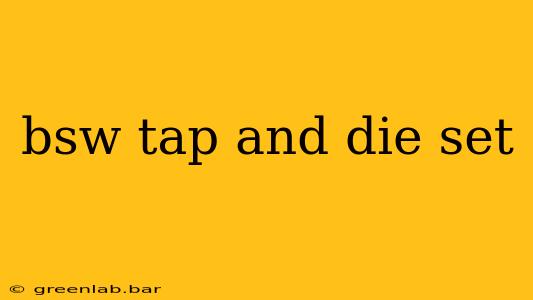Choosing the right tap and die set can be daunting, especially when dealing with British Standard Whitworth (BSW) threads. This comprehensive guide will walk you through everything you need to know about BSW tap and die sets, helping you select the perfect set for your projects. We'll cover the basics, delve into different types of sets, and offer tips for using them safely and effectively.
Understanding BSW Threads
Before diving into tap and die sets, it's crucial to understand BSW threads. Unlike the more common Unified Thread Standard (UTS) or Metric threads, BSW threads are defined by their specific Whitworth angle of 55 degrees and their rounded profile. This unique profile makes them slightly less efficient in terms of strength compared to other threading systems, but their historical significance remains in older machinery and components. Identifying the correct BSW thread size is crucial for a successful project. It is often represented by the diameter in inches followed by the number of threads per inch (TPI). For example, ¼"-20 BSW signifies a quarter-inch diameter with 20 threads per inch.
Types of BSW Tap and Die Sets
BSW tap and die sets are available in a variety of configurations, catering to different needs and budgets:
1. Individual Tap and Die Sets:
These sets contain a single tap and die of a specific size. They are ideal if you only need to work with one thread size. These are generally the most economical choice for single-use applications.
2. Fractional BSW Tap and Die Sets:
These sets typically include a range of commonly used fractional BSW sizes, such as ¼", 5/16", 3/8", 7/16", ½", etc. They are excellent for general-purpose applications where you might need to work with several different sizes. The number of dies and taps included varies greatly between manufacturers.
3. Comprehensive BSW Tap and Die Sets:
These sets offer a wider selection of BSW sizes, encompassing both fractional and potentially even some metric equivalents for broader coverage. They are more expensive but provide superior versatility for a wide range of projects. These often include a case for convenient storage and organization.
Choosing the Right BSW Tap and Die Set: Key Considerations
Several factors determine which BSW tap and die set is best for you:
- Frequency of Use: If you only occasionally need to cut threads, a smaller, more basic set will suffice. For frequent use, a more comprehensive set with a wider range of sizes is recommended.
- Project Requirements: Identify the specific BSW thread sizes your projects require. This helps narrow down the options and ensures you only purchase the tools you need.
- Budget: Prices vary significantly depending on the size, number of tools, and quality of the set. Set a realistic budget to guide your purchasing decision.
- Material: Consider the type of material you'll be working with. Some sets are specifically designed for harder materials, requiring more robust construction and potentially different tap styles.
Using Your BSW Tap and Die Set Safely and Effectively
- Proper Lubrication: Always use a cutting fluid or lubricant to minimize friction and heat buildup.
- Incremental Cutting: Make multiple passes with the tap, allowing for chip clearance and preventing thread breakage. Never force the tap.
- Die Stock: Use a die stock to ensure even pressure and alignment when cutting external threads.
- Cleanliness: Keep the area clean to prevent debris from interfering with the cutting process.
- Safety First: Always wear appropriate safety gear, including eye protection and gloves.
By carefully considering these points, you can choose the BSW tap and die set that perfectly fits your needs and ensures successful threading projects. Remember, investing in quality tools will not only save you time and frustration but also ensure a higher level of precision and a longer lifespan for your set.

